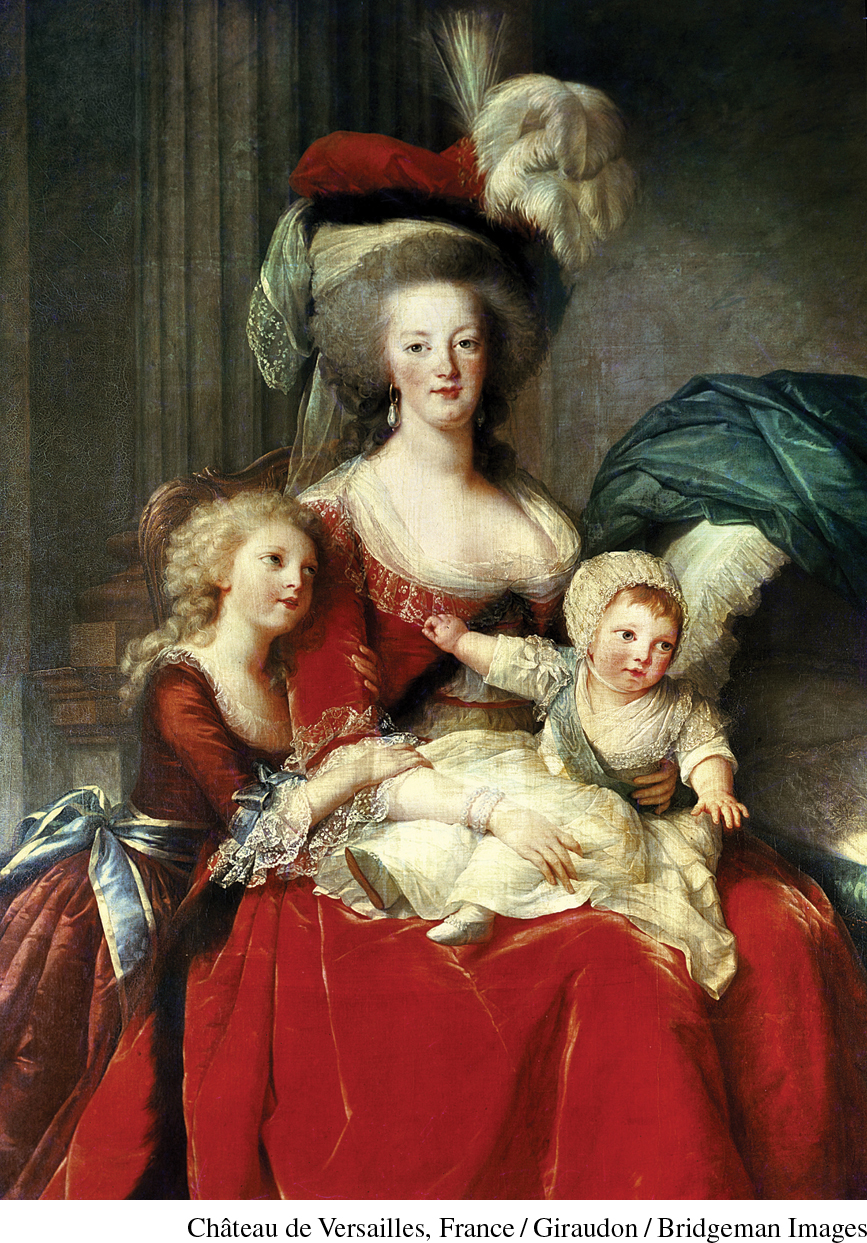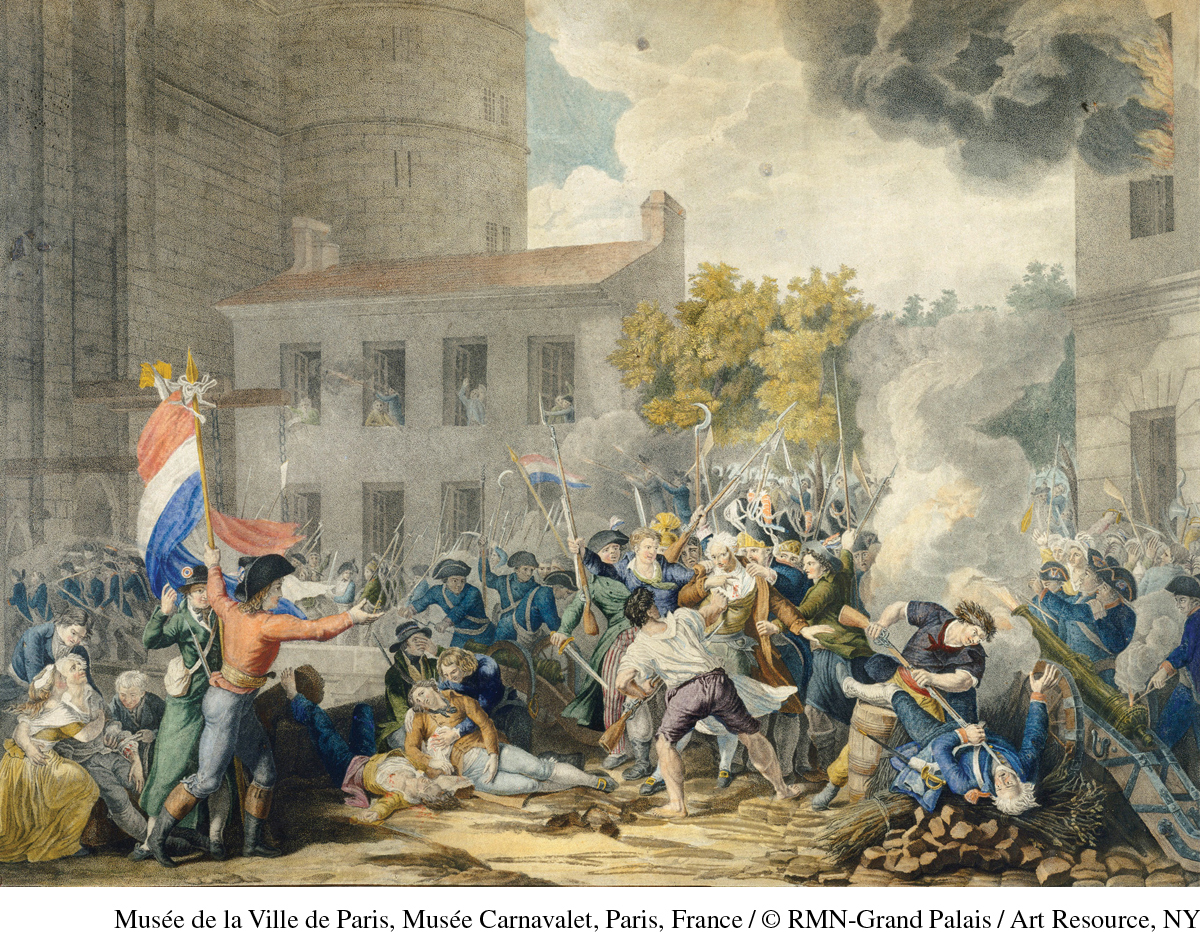Origins of the French Revolution, 1787–1789
Printed Page 609
Important EventsOrigins of the French Revolution, 1787–1789
Many French enthusiastically greeted the American experiment in republican government and supported the Dutch, Belgian, and Polish Patriots. After suffering humiliation at the hands of the British in the Seven Years’ War (1756–1763), the French had regained international prestige by supporting the victorious Americans. Yet by the late 1780s, the French monarchy was facing a serious fiscal crisis caused by a mounting deficit. The fiscal crisis soon provoked a constitutional crisis of epic proportions.
About half of the French national budget went to paying interest on the debt that had ballooned because of the American war. In contrast to the British government, which had a national bank to help raise loans, the French government lived off relatively short-term, high-interest loans from private sources, including Swiss banks, government annuities, and advances from tax collectors.
For years the French government had been trying unsuccessfully to modernize the tax system to make it more equitable. The peasants bore the greatest tax burden, whereas the nobles and clergy were largely exempt. Tax collection was also far from systematic: private contractors collected many taxes and pocketed a large share of the proceeds. With the growing support of public opinion, the bond and annuity holders from the middle and upper classes now demanded a clearer system of fiscal accountability.

In a monarchy, the ruler’s character is always crucial. Many complained that Louis XVI (r. 1774–1792) showed more interest in hunting and in his hobby of making locks than in the problems of government. His wife, Marie-Antoinette, was blond, beautiful, and much criticized for her extravagant taste in clothes, elaborate hairdos, and supposed indifference to popular misery. It was reported that, when told the poor had no bread, the queen gave a reply that has come to epitomize oblivious cold-heartedness: “Let them eat cake.” The queen, whom underground writers called the “Austrian bitch,” had been the target of an increasingly nasty pamphlet campaign in the 1780s. By 1789, Marie-Antoinette had become an object of popular hatred. The king’s ineffectiveness and the queen’s growing unpopularity helped undermine the monarchy as an institution.
Faced with a mounting deficit, in 1787 Louis submitted a package of reforms first to the Assembly of Notables and then to his old rival the parlement of Paris. Both refused to consider the reforms. Louis finally gave in to demands that he call a meeting of the Estates General, which had last met 175 years before.
The calling of the Estates General electrified public opinion. The Estates General was a body of deputies from the three estates, or orders, of France. The deputies in the First Estate represented some 170,000 priests, monks, and nuns of the Catholic church, which owned about 10 percent of the land in France and collected a 10 percent tax (the tithe) on peasants. The deputies of the Second Estate represented the nobility, about 140,000 men and women who owned about one-third of the land, enjoyed many tax exemptions, and collected seigneurial dues and rents from their peasant tenants. The deputies of the Third Estate represented everyone else, at least 95 percent of the nation. Included in the Third Estate were the vast mass of peasants, some 75 percent of the population, and the sans-culottes (“without breeches”) and middle classes of the cities. The sans-culottes were those who worked with their hands and wore long trousers rather than the knee breeches of the upper classes.
Before the elections to the Estates General in 1789, the king agreed to double the number of deputies from the Third Estate (making those deputies equal in number to the other two orders combined), but he refused to mandate voting by individual head rather than by order. Voting by order, allowing each order to have one vote, would conserve the traditional powers of the clergy and nobility; voting by head, allowing each deputy one vote, would give the Third Estate an advantage since many clergymen and even some nobles sympathized with the Third Estate.
As the state’s censorship apparatus broke down, pamphleteers by the hundreds denounced the traditional privileges of the nobility and clergy and called for voting by head rather than by order. In the most vitriolic of all the pamphlets, What Is the Third Estate?, the middle-class abbé (“abbot”) Emmanuel-Joseph Sieyès charged that the nobility contributed nothing at all to the nation’s well-being; they were, he said, “a malignant disease which preys upon and tortures the body of a sick man.” In the winter and spring of 1789, villagers and townspeople alike held meetings to elect deputies and write down their grievances. The effect was immediate. Although lawyers dominated the meetings at the regional level, the humblest peasants voted in their villages and burst forth with complaints, especially about taxes. One village meeting summed up the frustration: “misery is so great in the country that we cannot make enough complaints.” The long series of meetings raised expectations that the Estates General would help the king solve all the nation’s ills.
These new hopes soared just at the moment France experienced a food shortage, an increasingly rare but always dangerous situation. Bad weather had damaged the harvest of 1788, causing bread prices to rise dramatically in many places in the spring and summer of 1789 and threatening starvation for the poorest people. In addition, a serious slump in textile production had been causing massive unemployment since 1786. Hundreds of thousands of textile workers were out of work and hungry, adding another volatile element to an already tense situation.
When some twelve hundred deputies journeyed to the king’s palace of Versailles for the opening of the Estates General in May 1789, many readers avidly followed the developments in newspapers that sprouted overnight. Although most nobles insisted on voting by order, the deputies of the Third Estate refused to proceed on that basis. After six weeks of stalemate, the deputies of the Third Estate took unilateral action on June 17 and declared themselves and whoever would join them the National Assembly, in which each deputy would vote as an individual. Two days later, the clergy voted by a narrow margin to join them. Suddenly denied access to their meeting hall on June 20, the deputies met on a nearby tennis court and swore an oath not to disband until they had given France a constitution that reflected their newly declared authority. This “tennis court oath” expressed the determination of the Third Estate to carry through a constitutional revolution.

At first, Louis XVI appeared to agree to the new National Assembly, but he also ordered thousands of soldiers to march to Paris. The deputies who supported the Assembly feared a plot to arrest them and disperse the Assembly. Their fears were confirmed when, on July 11, the king fired Jacques Necker, the Swiss Protestant finance minister and the one high official regarded as sympathetic to the deputies’ cause.
The popular reaction in Paris changed the course of the French Revolution. When the news spread, the sans-culottes in Paris began to arm themselves and attack places where either grain or arms were thought to be stored. A deputy in Versailles reported home: “Today all of the evils overwhelm France, and we are between despotism, carnage, and famine.” On July 14, an armed crowd marched on the Bastille, a huge fortified prison that symbolized royal authority (even though only a few prisoners were actually incarcerated there). After a chaotic battle in which a hundred armed citizens died, the prison officials surrendered.

REVIEW QUESTION How did the beginning of the French Revolution resemble the other revolutions of 1787–1789?
The fall of the Bastille (an event now commemorated each July 14 as the French national holiday) set an important precedent. The common people showed themselves willing to intervene violently at a crucial political moment. All over France, local governments were forced out of power and replaced by committees of “patriots.” To restore order, the patriots relied on newly formed National Guard units composed of civilians. In Paris, the Marquis de Lafayette, a hero of the American War of Independence and a noble deputy in the National Assembly, became commander of the new National Guard. One of Louis XVI’s brothers and many other leading aristocrats fled into exile. The Revolution thus had its first heroes, its first victims, and its first enemies.